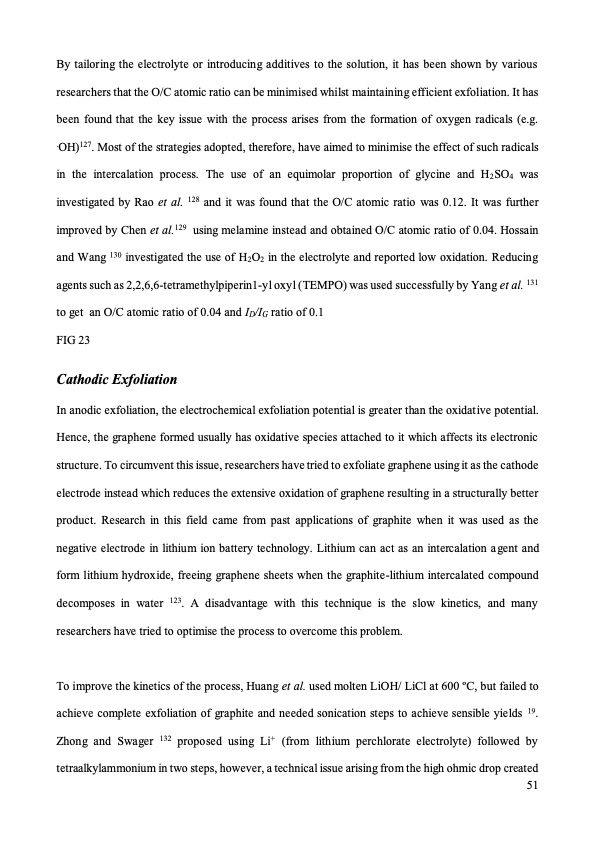
PDF Publication Title:
Text from PDF Page: 051
By tailoring the electrolyte or introducing additives to the solution, it has been shown by various researchers that the O/C atomic ratio can be minimised whilst maintaining efficient exfoliation. It has been found that the key issue with the process arises from the formation of oxygen radicals (e.g. .OH)127. Most of the strategies adopted, therefore, have aimed to minimise the effect of such radicals in the intercalation process. The use of an equimolar proportion of glycine and H2SO4 was investigated by Rao et al. 128 and it was found that the O/C atomic ratio was 0.12. It was further improved by Chen et al.129 using melamine instead and obtained O/C atomic ratio of 0.04. Hossain and Wang 130 investigated the use of H2O2 in the electrolyte and reported low oxidation. Reducing agents such as 2,2,6,6-tetramethylpiperin1-yl oxyl (TEMPO) was used successfully by Yang et al. 131 to get an O/C atomic ratio of 0.04 and ID/IG ratio of 0.1 FIG 23 Cathodic Exfoliation In anodic exfoliation, the electrochemical exfoliation potential is greater than the oxidative potential. Hence, the graphene formed usually has oxidative species attached to it which affects its electronic structure. To circumvent this issue, researchers have tried to exfoliate graphene using it as the cathode electrode instead which reduces the extensive oxidation of graphene resulting in a structurally better product. Research in this field came from past applications of graphite when it was used as the negative electrode in lithium ion battery technology. Lithium can act as an intercalation agent and form lithium hydroxide, freeing graphene sheets when the graphite-lithium intercalated compound decomposes in water 123. A disadvantage with this technique is the slow kinetics, and many researchers have tried to optimise the process to overcome this problem. To improve the kinetics of the process, Huang et al. used molten LiOH/ LiCl at 600 oC, but failed to achieve complete exfoliation of graphite and needed sonication steps to achieve sensible yields 19. Zhong and Swager 132 proposed using Li+ (from lithium perchlorate electrolyte) followed by tetraalkylammonium in two steps, however, a technical issue arising from the high ohmic drop created 51PDF Image | graphene production via nonoxidizing liquid exfoliation

PDF Search Title:
graphene production via nonoxidizing liquid exfoliationOriginal File Name Searched:
Graphene-R2-review.pdfDIY PDF Search: Google It | Yahoo | Bing
Salgenx Redox Flow Battery Technology: Power up your energy storage game with Salgenx Salt Water Battery. With its advanced technology, the flow battery provides reliable, scalable, and sustainable energy storage for utility-scale projects. Upgrade to a Salgenx flow battery today and take control of your energy future.
| CONTACT TEL: 608-238-6001 Email: greg@infinityturbine.com | RSS | AMP |